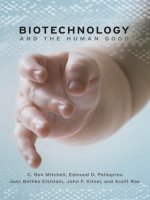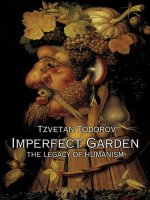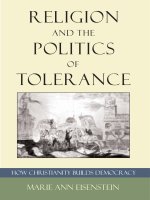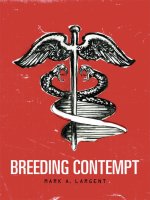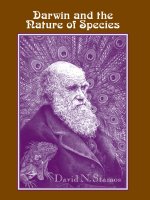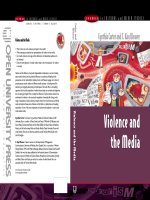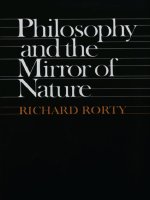baylor university press religion and the politics of tolerance how christianity builds democracy jan 2008
Bạn đang xem bản rút gọn của tài liệu. Xem và tải ngay bản đầy đủ của tài liệu tại đây (2.23 MB, 190 trang )
RELIGION
AND THE
OF
POLITICS
TOLERANCE
Marie Ann Eisenstein
How Christianity Builds Democracy
Eisenstein
RELIGION
AND THE POLITICS OF TOLERANCE
Challenging a widespread belief that religious people are politically
intolerant, Marie Ann Eisenstein offers compelling evidence to the con-
trary. She thoroughly reexamines previous studies and presents new
research to support her argument that there is, in fact, a positive corre-
lation between religious belief and practice and political tolerance in
the United States.
Eisenstein utilizes sophisticated new analytical tools to reevaluate earlier
data and offers persuasive new statistical evidence to support her claim
that religiousness and political tolerance do, indeed, mix—and that reli-
giosity is not the threat to liberal democracy that it is often made out to be.
Professor Eisenstein has provided a valuable addition to the literature
on political tolerance. She demonstrates theoretical sophistication and
methodological innovation as she modifies our understanding of the
relationship between religion and tolerance. This is an important book.
—Ted G. Jelen, Professor and Chair of Political Science,
University of Nevada at Las Vegas
A valuable study by a very promising new scholar of religion and politics.
Using a variety of sources—including surveys, focus group research, and
a thorough literature review—Eisenstein nicely demonstrates how mod-
ern religion and political tolerance work hand-in-hand to foster the val-
ues of a liberal democracy in the U.S. This book therefore makes a strong
case against the common assumption of many observers that religion fos-
ters intolerance and that it undermines liberal democratic values.
—Mark J. Rozell, Professor, School of Public Policy, George
Mason University
Marie A. Eisenstein (Ph.D. Purdue University) is Assistant Professor of
Political Science in the School of Public and Environmental Affairs-
Political Science, Indiana University Northwest.
ISBN 978-1-932792-84-3
baylorpress.com
Religion and the Politics of Tolerance
h
Religion and the Politics of Tolerance
How Christianity Builds Democracy
Marie A. Eisenstein
Baylor University Press
© 2008 by Baylor University Press
Waco, Texas 76798
All Rights Reserved. No part of this publication may be reproduced,
stored in a retrieval system, or transmitted, in any form or by any
means, electronic, mechanical, photocopying, recording or other-
wise, without the prior permission in writing of Baylor University
Press.
Cover Designer: Stephanie Blumenthal
Cover Image: Cartoon# 0076063 from The Granger Collection.
Used by Permission
Library of Congress Cataloging-in-Publication Data
Eisenstein, Marie Ann.
Religion and the politics of tolerance : how Christianity builds
democracy / Marie Ann Eisenstein.
p. cm.
Includes bibliographical references and index.
ISBN 978-1-932792-84-3 (alk. paper)
1. Religion and politics United States. 2. Democracy Religious
aspects. 3. Toleration Religious aspects. I. Title.
BL2525.E418 2008
261.7 dc22
2007026447
Printed in the United States of America on acid-free paper with a
minimum of 30% pcw recycled content.
To the G-d of all creation,
the G-d who encompasses all and is all and
who is the author and creator of everything.
h
vii
Table of Contents
List of Tables and Figures ix
Acknowledgments xi
Introduction 1
1 The Politics of Tolerance 13
2 Christian Political Tolerance in Contemporary America 33
3 What Do Christian Congregants Say about Themselves? 61
4 Issue Attitudes, Religion, and Political Tolerance 93
5 Political Intolerance: Is It Really not about Religion? 115
Appendices 131
A Survey 131
B Focus Group Session Script 141
C “Your Help Is Needed” Flier 143
D Phone Script 144
E Informed Consent Statement 145
F Political Attitudes Questionnaire 147
Notes 153
References 165
Index 173
h
ix
List of Tables and Figures
Tables
Table 2.1 Demographics of My Data Set 37
Table 2.2 Content-Controlled Political Tolerance Scale
Items 39
Table 2.3 Respondents Least-Liked Group 44
Table 2.4 Respondents Least-Liked Group by Religious
Tradition 45
Table 2.5 Political Party by Religious Tradition 46
Table 3.1 Focus Group Session Information 67
Table 4.1 Issue Attitude Question Writing 91
Table 4.2 Factorial ANOVA Design (Context by Religious
Tradition with Religious Commitment) 104
Table 4.3 Context by Religious Tradition (As a Single
Predictor Variable) 106
Table 4.4 Mean Issue Attitude Scores (Tradition by Context) 107
Table 4.5 Political Tolerance 109
Table 4.6 Political Tolerance Factorial ANOVA Design
(Context by Issue Attitude) 110
Table 4.7 Political Tolerance Factorial ANOVA Design
(Context by Level of Opposition) 111
Figures
Figure 2.1 Basic Religious Model of Political Tolerance 38
Figure 2.2 Model Results for All Respondents 47
Figure 2.3A Model Results by Religious Tradition 49
Figure 2.3B Model Results by Religious Tradition 51
Figure 2.4 Advanced Model of Political Tolerance 52
Figure 2.5 Results for Advanced Model of Political Tolerance 53
Figure 2.6A Advanced Model Results by Religious Tradition 56
Figure 2.6B Model Results by Religious Tradition 58
Figure 4.1 Mean Abortion Score by Context 101
Figure 4.2 Mean Stem Cell Research by Context 102
x List of Tables and Figures
h
xi
Acknowledgments
In producing this book, I owe a debt of gratitude to many individu-
als who encouraged, guided, and helped me through this process.
I know I cannot list them all. My husband Maurice Eisenstein and
my parents Ronald and Rose Prescaro have been consistent sources
of encouragement, strength, and support. Where or who would I be
without you?
To Carey Newman at Baylor University Press; thank you for
believing in my manuscript. You are the publisher of my rst book
and for that I am truly grateful. I hope that it is the rst (but not the
best) among many more to come.
To Ted Jelen and Laura Olson, both of whom willingly and speed-
ily reviewed everything I asked them to review for me. I truly appre-
ciate your gifts of time, eort, and intellect.
To Indiana University Northwest for granting me summer fel-
lowships during 2005 and 2006 that enabled me to work on and com-
plete this manuscript. Thank you.
h
1
Certainly, no power to prescribe any religious exercise, or to assume
authority in religious discipline, has been delegated to the General
Government. It must then rest with the States, as far as it can be in any
human authority.
—Thomas Jeerson to Samuel Miller, January 23, 1808
The American political landscape is replete with the perceived
incompatibility between our political ideals and religious beliefs.
In the U.S. Constitution, the First Amendment exemplies this very
contradiction even within its religious clauses. Of all the rights enu-
merated in the Bill of Rights, only religion has spelled-out dual and
frequently contradictory rights—the establishment clause and the
free exercise clause. The state cannot favor any particular religion
over any other; and as it is frequently interpreted in contemporary
jurisprudence, it cannot favor any religion at all. Simultaneously,
the state cannot act in any way to prevent an individual’s exercise
of his or her religious belief. The rst clause requires the state to
be neutral in all religious matters—in a sense, putting the state
above religion. The second clause requires the state to recognize
the supremacy of religious practices over the everyday concerns of
the state. Recently, France passed a law banning all exterior expres-
sions of religious beliefs in public schools, deeming this necessary
for upholding the secular nature of the French political state. In the
United States, this fullls the rst clause (the establishment clause),
Introduction
2 Religion and the Politics of Tolerance
but is antithetical to the second clause (the free exercise clause).
Americans would recognize that secularization is a positive act and
abridges an inherent right.
The Jeersonian Inuence
Perhaps no other single individual has had more inuence on our
modern interpretation of the First Amendment religious clauses and
on our twenty-rst-century notions of appropriate church-state
relations than Thomas Jeerson. Actually, it was James Madison who
penned the religious clauses of the First Amendment while Jeerson
was in France—and Madison was as much a supporter of religious
freedom as Jeerson. It is also recognized that Madison’s written
defense of the religious clauses is as important to the founding of
this country as Jeerson’s. Nonetheless, in contemporary politi-
cal discussion concerning the constitutional interpretation of the
political role of religion, Jeerson consistently prevails as the pre-
eminent voice. “Jeerson’s architectural metaphor, in the course of
time, has achieved virtual canonical status and become more famil-
iar to the American people than the actual text of the First Amend-
ment” (Dreisbach 2002, 3).
In 1802, as president of the United States, Thomas Jeerson
penned a letter to the Danbury Baptist Association of Connecticut.
In it, he stated:
Believing with you that religion is a matter which lies solely
between Man & His God, that he owes account to none other for
his faith or his worship, that the legitimate powers of government
reach actions only, & not opinions, I contemplate with sovereign
reverence that act of the whole American people which declared
that their legislature should “make no law respecting an estab-
lishment of religion, or prohibiting the free exercise thereof,”
thus building a wall of separation between Church & State (Dreisbach
2002, 1–2; italics added).
From his bully pulpit as the third president of the United States, Jef-
ferson took up the issue of religious freedom when he was compelled
to espouse his views of the religious clauses in the First Amend-
ment, Jeerson wrote the letter to the Danbury Baptists to address
the sti political criticism he was receiving from the federalists,
and it provided him a public venue to identify his “wall” analogy.
As an ardent anti-federalist with a profound commitment to dual
Introduction 3
federalism, Jeerson refused to declare national days of fasting or
thanksgiving, believing that such declarations were beyond the pur-
view of the national government. Such declarations were appropri-
ate for the individual state authority, but not for national or federal
authority. However, Jeerson’s refusal to pronounce days of fasting
and thanksgiving reects both his commitment to ensuring appro-
priate church-state relations and his views concerning federalism’s
boundaries between state and national authority. Jeerson, with the
phrase “a wall of separation” indicated unequivocally his reading
and understanding of the religious clauses of the First Amendment.
Jeerson’s statement in the Danbury letter is consistent with
his long-held, lifelong views concerning church-state relations.
Although his statements on freedom of the press may be less than
perfectly consistent over time, the same cannot be said for church
and state. Leonard Levy, surely the harshest critic of Jeerson’s over-
all record in civil rights and liberties, conceded but one area in which
he felt adulation was well deserved—the relationship between gov-
ernment and religion. Only one other president ever refused to issue
thanksgiving proclamations because he felt such a decree would
cross the line between church and state. In countless other ways,
the Jeersonian commitment to separation is remarkably clear and
consistent, despite the political hazards of an arguably godless phi-
losophy (O’Neil 1999, 793).
An example of one of the “countless other ways” in which Jef-
ferson demonstrated his commitment to separation between church
and state is in his support of free and tax-supported nonsectar-
ian public schools (Wood 1979). In short, Jeerson’s Danbury letter
clearly articulated both his commitment to and philosophy of inex-
ible separation between church and state as an appropriate relation-
ship. Though none of us in twenty-rst-century America can escape
the imprint of the “wall of separation” metaphor upon our national
psyche, the phrase was a mere historical anecdote until it surfaced
in 1879. After that, it remained dormant until 1947. From that point
on, however, the “wall of separation” has grown to become part and
parcel of our national identity in discussions regarding the religious
clauses in the First Amendment.
With the 1879 Reynolds v. United States case, the Supreme Court
for the rst time employed the “wall of separation” metaphor in one
of its decisions. Reynolds, a case about the free exercise of religion as
opposed to the establishment clause, stands as one of the few cases
4 Religion and the Politics of Tolerance
dealing with either of the religious clauses of the First Amendment
during the rst 150 years of American history. In a thorough and
engaging scholarly assessment as to why the Supreme Court in 1879
used this phrase in one of its decisions, the answer turns on the
ironic (Dreisbach 2002, chap. 7). The 1879 Court sought to delineate
that while the national legislature could proscribe behavior, it could
not proscribe opinion (regarding religion). In the 1802 Danbury
letter, Jeerson stated that “the legitimate powers of government
reach actions only, & not opinion” (Dreisbach 2002, 48). However, the
word “legitimate” had been incorrectly transcribed as “legislative”
and, as a result, Jeerson’s Danbury letter served the very purpose
of the 1879 Court when it sought to support the Court’s ruling that
religious action deemed contrary to the public good can be legis-
lated against while opinion cannot be subject to the actions of the
legislature.
Thomas Jeerson’s “wall of separation” was now a part of consti-
tutional jurisprudence and the metaphor was now part of the Amer-
ican lexicon. It would remain dormant and not become common
parlance, as we now recognize the reference, until 1947. In the words
of Kenneth D. Wald (2003, 90), “In 1947 the Court decided a case that
was to herald a ood of litigation about the modern meaning of First
Amendment prohibitions ‘respecting an establishment of religion.’”
The case was Everson v. Board of Education. In that case, Justice Black,
writing for the majority, concluded that “(t)he First Amendment has
erected a wall of separation between church and state. That wall
must be kept high and impregnable. We could not approve the slight-
est breach” (Alley 1999, 54). Nonetheless, the majority opinion in
the Everson case upheld New Jersey’s funding of bus transportation
for parochial school students, which many individuals today would
nd counter-intuitive to the above statement made by Justice Black.
“Although the outcome in Everson v. Board of Education was benecial
to the religious students who were the recipients of public trans-
portation, the majority’s analysis was decidedly unfavorable to their
long-term First Amendment position” (Reid 2003, 82). The opinion in
Everson was that New Jersey had not breached the wall of separation
between church and state, but, in the future, such breaches would
be accepted only under the narrowest of circumstances.
With the Everson case, the “wall of separation” rose from an
obscure background reference to the front and center of American
constitutional jurisprudence regarding the First Amendment reli-
Introduction 5
gious clauses. The phrase was no longer to be solely a metaphor; it
would become “a virtual rule of constitutional law” (Dreisbach 2002,
3). The Everson case marks our modern understanding and inter-
pretation of the religious clauses, particularly as it pertains to what
constitutes an establishment of religion. After Everson, many cases
regarding the religious clauses of the First Amendment came before
the Supreme Court; however, issues regarding the public school sys-
tem were most important both in terms of number of cases and the
substance of Court decisions. Writing in 1979 about the place of reli-
gion within the context of public education, James E. Wood Jr. stated:
“During the past thirty years no other church-state issues have pro-
voked as much litigation” (1979, 64). The same can still be said today.
More importantly, the Everson case made clear that the historical
writings of Jeerson (and Madison as well) were the basis for deter-
mining just what the religious clauses in the First Amendment were
intended to mean.
Soon thereafter, in 1948, the next important case to establish
the wall of separation as the “virtual rule” of constitutional law for
the establishment clause was McCollum v. Board of Education. Using
the logic articulated in Everson, in which a breach of the wall of
separation between church and state could be allowed in only the
narrowest circumstances and that the wall must be “high and
impregnable,” the Court found in the McCollum case that the wall
had been breached. The McCollum case asserted that allowing reli-
gious instruction to take place during regular school hours—even
if the students did so voluntarily—constituted an establishment of
religion. With Everson and McCollum, “an imposing edice has been
constructed” (Reid 2003, 87) and “the Supreme Court expanded its
use of the prohibition of establishments in the early 1960s to school
prayer” (2003, 87).
Engel v. Vitale in 1962 was the rst signicant case on the question
of school prayer. The case dealt with the New York Regents’ Prayer “a
nondenominational invocation to be recited daily by teachers in the
public school system. School children were free to choose whether
or not to participate. In yet another opinion by Hugo Black, the Court
struck down the practice” (Reid 2003, 87). The next important case
on the matter of school prayer was Abington School District v. Schempp.
In Abington, the Supreme Court again ruled against the school dis-
trict for requiring the reading of Bible verses and saying the Lord’s
Prayer at the beginning of each school day. The Court’s rulings in
6 Religion and the Politics of Tolerance
both Engel and Abington strongly endorsed the concept that any
religious conduct promoted or facilitated by an institution of gov-
ernment (such as a public school paid for by tax dollars) represents
an establishment of religion and constitutes a breach of that wall of
separation advocated by Jeerson (Wald 2003, 91). Jeerson’s phrase
had now become the accepted and recognized basis for interpreting
the establishment clause in the First Amendment.
Theory versus Practice
Thomas Jeerson dened the relationship between American poli-
tics and religion as one of absolute separation between church and
state. Not only did he famously call for a high “wall” between the
two, but the Supreme Court repeatedly has applied his “wall of sep-
aration” in its interpretation of church-state relations. The fact is,
however, that the practice of separation has not proved to be true in
fact or in predominant citizen belief. Rather, the “absolute” separa-
tion of religion and state has remained uid and changeable over
time—the result of two conicting clauses on religious practice in
the Constitution. In a liberal democracy, one can pursue an abso-
lute separation of church and state, but one cannot ask for or pur-
sue an absolute separation of religion and politics. These are two
radically dierent pursuits; the rst one is institutional, the latter
is behavioral. The relationship between religion and politics is at the
individual level because it is there that political will is exercised;
therefore, it is counter-intuitive to believe that a religious individual
can, in any meaningful way, divorce himself or herself from a pro-
fessed set of beliefs when behaving as a political actor. This is what
the free exercise clause is intended to protect. Partly because of the
inherent tension between the separation of institutions and the free
exercise of individuals, the Court found that unequivocal applica-
tion of Jeerson’s separationist interpretation “proved surprisingly
dicult” (Schotten & Stevens 1996, 69).
1
The important issues to address are the reasons that Thomas
Jeerson felt the need for a comprehensive and absolute separa-
tion between church and state and the reasons that the Ameri-
can political system, uniquely, found it necessary to protect not
solely religion from the state but, signicantly, the state from reli-
gion. Thomas Jeerson’s enlightenment perspective accepted the
inherent incompatibility of religious belief and liberal democratic
Introduction 7
politics—a perspective that rests on the idea that the very action of
expressing religious belief requires an individual to be intolerant of
other individuals of dissimilar beliefs. This enlightenment percep-
tion was that religion is about absolutes and liberal democratic poli-
tics is about compromise and tolerance (i.e., being a gracious loser);
therefore, it is impossible to practice both within the same arena.
In John Dewey’s terms, liberal democratic politics was for the public
arena and religion was for the private arena.
The dichotomy that politics is for the public arena and religion
for the private arena has not only dened American perception of
the First Amendment, but it also has made modern political sci-
ence a component of modern democratic theory. Intolerance is the
major threat to both the establishment of liberal democracy and the
continued functioning of established liberal democracies. Intoler-
ance, which rejects the legitimacy of other individuals to equally
participate in the political process, preordains who does and does
not have legitimacy before the political process. This preordination,
therefore, negates the need to compromise. Intolerance is not lim-
ited solely to religious individuals, but religious individuals often
are perceived to be consistently the most intolerant. The greater the
level of religious commitment, the less tolerance one has for others
of dissimilar beliefs. Therefore, the individual of high religious com-
mitment is less likely to promote liberal democracy and its require-
ment of tolerance—especially when he or she is in power.
The theoretical logic of the arguments that have held sway
against religion and the democratic value of tolerance (or its nega-
tive intolerance) since the writing of the U.S. Constitution is consis-
tent with the enlightenment perspective on religiosity, and it can
be understood in terms of classical liberal opposition to the church.
But it is not clear that this attribute of religion is an accurate rep-
resentation, especially within modern American liberal democratic
practice. Alternatively, it can be argued that the very nature of reli-
gion has gone through a metamorphosis in the United States, mak-
ing religious individuals no less tolerant, or possibly more tolerant,
than their less religious neighbors. It is possible that the socializa-
tion of American liberal democratic values that permeate religion in
the United States negates the European tradition of intolerance for
which religion has been ascribed by the Jeersonian enlightenment.
These are the central themes of this book.
8 Religion and the Politics of Tolerance
Religious Faith and Tolerance
The historical expressions of intolerance by identiably religious
individuals are well known. What is frequently overlooked and
therefore not attributed to religious faith is its responsibility for
major acts of tolerance in American history. Abolition was a move-
ment supported not only by the dominant forms of Christianity of
the time but had its roots in the Quaker opposition to slavery in
the late seventeenth century (Butler, Wacker, & Balmer 2003, 202).
Another is the Civil Rights movement that had large Catholic and
Jewish religious initiation and support, along with the leadership
of Reverend Martin Luther King Jr., who used overtly religious lan-
guage and themes. Then there is social welfare, which is best exem-
plied by the Catholic Church as it established hospitals and other
institutions in many parts of America to provide for those in need.
It is less known that the modern evangelical movement, in
large part, was started in California by a black preacher and for-
mer hotel waiter named William J. Seymour. This new Pentecostal
movement was known as the Azusa Street Revival and drew national
and international recognition, to a great extent, because of its tol-
erance of whites and blacks worshiping together. Not only was the
Azusa Street Pentecostal movement racially integrated (as were
others across the nation), but also women preachers had equal par-
ticipation. This tolerant religion spread across the country, in the
north and south, and its own national newspaper developed. All this
occurred in 1905 (Butler et al. 2003, 335–36). This tradition of gender
and racial tolerance has continued today in many of the evangelical
churches where racial integration is the norm and women preachers
have full equality.
We owe to these individuals the enhancement of our under-
standing of religions’ role in the United States in its relationship to
the nature of political tolerance in particular and liberal democracy
in general. The central argument of this book is straightforward:
religion is not the dominant threat to liberal democracy in the
United States that it is so often portrayed to be. Alan Wolfe states:
Religious believers blend into the modern American landscape.
They increasingly live in suburbs, send their children to four-
year liberal-arts colleges, work in professional capacities, enjoy
contemporary music, shop in malls, raise confused and uncertain
Introduction 9
children, and relate primarily to other people with whom they
share common interests (Wolfe 2003, 255).
Wolfe makes the case that religion in America has gone through
dramatic changes including “a palpable increase in religious tolera-
tion that extends to non-Christians” (Wolfe 2003, 248). Yet, as Wolfe
indicates, these dramatic changes have been hardly noticed in the
public arena, particularly by intellectuals who act as though “Jona-
than Edwards is still preaching and his congregation is still quaking
in fear” (Wolfe 2003, 249). Thus, the argument of this book may be
a simple statement, but demonstrating the argument, which is the
task at hand, is complex and full of challenges.
Scope of Project
The central themes of this book—liberal democracy, political toler-
ance, and religion—are weighty themes. Likewise, supporting the
foundational argument of this book—that religion is not a domi-
nant threat to liberal democracy in the United States, particularly
as it relates to political tolerance—is a weighty undertaking. These
themes are continuously discussed, debated, and analyzed in vari-
ous academic elds including, but not limited to, political theory,
philosophy, history, religious studies, comparative studies in politi-
cal science and religion, the psychology of religion, and sociology
(in particular, the sociology of religion), in addition to scholarship
that tackles these issues from the perspective of legal tradition.
2
Furthermore, within each of these various academic postures, the
methodological norms of what constitutes scholarly investiga-
tion and analysis diers (statistical, experimental, ethnographic,
hagiographic, hermeneutic, case study, etc.), which means within
two dierent academic perspectives analogous discussions may be
occurring but the scholarly literature for each venue is separate and
unique. In short, there are other approaches to studying the topic
and issues of religion and political tolerance than that which is pre-
sented here.
This book, though, is not intended to be considered interdis-
ciplinary or cross-disciplinary in nature. It does not pretend or
claim to incorporate the comprehensive intellectual grasp of all
the various academic disciplines in which issues of liberal democ-
racy, religion, and political tolerance are discussed, debated, and
analyzed. Also, this work does not touch upon, let alone encompass,
the breadth, width, and depth of these various academic arenas. As
an empirically trained political scientist, I approach this topic from
a perspective that is very much inuenced by empirical social sci-
ence in methodology and issue framing. Therefore, this book is most
appropriately placed within the academic discipline of political sci-
ence in general, and the religion and politics subeld, in particu-
lar. Consequently, the literature I use to inform the discussion and
analyses throughout this book is drawn predominantly from works
familiar to academicians within political science. Specically, the
literature regarding political tolerance is from within mainstream
political science scholarship while the literature regarding reli-
gion/religiosity primarily is from the religion and politics subeld
of political science.
3
In this book, I reference some works that fall
outside of what I call the academic “silo” of political science. But this
is only to admit, right from the start, that for those whose expertise
falls outside of the predominantly quantitative eld of political sci-
ence, this book will not do justice to the considerable scholarship
committed to these topics, especially when their expertise falls out-
side the particular area of inquiry represented in this work.
In chapter 1, I review the concept of political tolerance, which
places the text explicitly within the mainstream political science
scholarship as well as the religion and politics literature. Bringing
together these two literary arenas provides the basis and ratio-
nale for the whole book, which includes chapters that reexamine
the relationship between religion and political tolerance in liberal
democracy and that support the contention that religion is not the
threat to liberal democracy that it generally has been purported to
be. Beginning with chapter 2, I bring a multiplicity of data sources
to bear on this topic, including an examination of data from a ran-
dom sample phone survey of 600 respondents (a purely quantitative
undertaking). I marshal empirical evidence from structural equa-
tion modeling to begin to make the case for a new understanding of
the link between religion/religiosity and political tolerance.
In chapter 3, I utilize focus group research (a qualitative tech-
nique not common to political science scholarship). It is important to
hear, in their own words, what individuals of faith have to say about
the relationship between faith and democracy. Therefore, I turn to
a qualitative assessment of the linkage between modern Christian
congregants and their understanding of the relationship between
10 Religion and the Politics of Tolerance
Introduction 11
their faith and their role as citizens in a liberal democracy. The pri-
mary purpose of this chapter is to explore how religious individuals
navigate the relationship between their faith and participation in a
liberal democracy, which, in general, includes political tolerance.
In chapter 4, I analyze data from a survey-based experimental
design and begin to address the potential linkages between issue-
attitude positions and political tolerance. Because of the intense
current debate over social and moral issues, this chapter addresses
that debate and is essential for no other reason than the popular
perception, as it relates to what colloquially can be called “conserva-
tive Christian right” attitudes toward various topics (such as abor-
tion and homosexual marriage) are often considered a priori proof
of political intolerance. Given the importance in today’s politically
charged environment between hot-button political issue attitudes
and perceptions of tolerance versus intolerance, empirical research
examining potential linkages is a necessary and important area of
scholarship.
Chapter 5 concludes with a summary of the overall ndings of
the book and brings together all the various research strands to
paint a contemporary picture of religion and religiosity in America
as it relates to political tolerance. In this nal chapter, all the infor-
mation from the previous chapters come together as I argue for a
positive—not negative—relationship between religion and religios-
ity and liberal democracy in the United States.
Before we move into chapter 1, two additional caveats need to
be expressed. First, throughout this book—chapters 2, 3, and 4 in
particular—my goal is to address, with a multiplicity of methods
(including quantitative, qualitative, and experimental), the rela-
tionship between religion, political tolerance, and liberal democ-
racy. However, all three data sets used in this book are drawn from
a single place—Lake County, Indiana. This means that although the
discussion of religion, political tolerance, and liberal democracy is
one of national import, the particular data used in that discussion
is regional in nature. The specic limitations and unique regional
attributes of each data set are discussed, as needed, in the chapters
in which each data set is employed.
I do not want to understate the applicability of my ndings
based upon my data sets. There is valid reason to conclude that
similarity in religiosity and political tolerance in one Midwestern
county can be expected to exist in other Midwestern counties. The
data here are from a single county within a single state, and ques-
tions undoubtedly will follow regarding how we can generalize from
this data. But there is, I believe, a legitimate argument to be made
that these samples are representative of the beliefs and attitudes of
“middle America.” In the same way, I do not want to overstate the
applicability of my ndings. The data sets are generally smaller than
ideally desired, which has its drawbacks and raises questions about
the ability to generalize. But the data sets are adequate to allow the
ndings presented here to be considered highly suggestive, even
though they ultimately cannot be deemed conclusive.
Finally, this book deals strictly with religion within the context
of a modern American political system. There is no argument that
the models proposed in this book would be universally applicable
outside their political context, such as laterally to Muslims in Saudi
Arabia or retrospectively to more theocratic societies. For example,
because of their religious history, Catholics in Mexico will have dif-
ferent political values than Catholics in the United States. The anal-
yses throughout this book rely upon a concept of political tolerance
consistent with a liberal democratic society. Furthermore, these
analyses rely on a unique integration of the values of liberal democ-
racy with the experience of religion and religiosity within America
in the twenty-rst century.
12 Religion and the Politics of Tolerance


